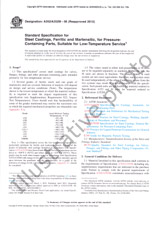We need your consent to use the individual data so that you can see information about your interests, among other things. Click "OK" to give your consent.
ASTM E96/E96M-16
Standard Test Methods for Water Vapor Transmission of Materials
STANDARD published on 1.3.2016
The information about the standard:
Designation standards: ASTM E96/E96M-16
Note: WITHDRAWN
Publication date standards: 1.3.2016
SKU: NS-635714
The number of pages: 14
Approximate weight : 42 g (0.09 lbs)
Country: American technical standard
Category: Technical standards ASTM
The category - similar standards:
Annotation of standard text ASTM E96/E96M-16 :
Keywords:
permeability, plastics (general), plastic sheet and film, sheet material, thermal-insulating materials, thermal insulation permeability films, water vapor transmission (WVT),, ICS Number Code 77.040.99 (Other methods of testing metals)
Additional information
| Significance and Use | ||||||||||||
|
5.1 The purpose of these tests is to obtain, by means of simple apparatus, reliable values of water vapor transfer through permeable and semipermeable materials, expressed in suitable units. These values are for use in design, manufacture, and marketing. A permeance value obtained under one set of test conditions may not indicate the value under a different set of conditions. For this reason, the test conditions should be selected that most closely approach the conditions of use. While any set of conditions may be used and those conditions reported, standard conditions that have been useful are shown in Appendix X1. |
||||||||||||
| 1. Scope | ||||||||||||
|
1.1 These test methods cover the determination of water vapor transmission (WVT) of materials through which the passage of water vapor may be of importance, such as paper, plastic films, other sheet materials, fiberboards, gypsum and plaster products, wood products, and plastics. The test methods are limited to specimens not over 11/4 in. [32 mm] in thickness except as provided in Section 9. Two basic methods, the Desiccant Method and the Water Method, are provided for the measurement of permeance, and two variations include service conditions with one side wetted and service conditions with low humidity on one side and high humidity on the other. Agreement should not be expected between results obtained by different methods. The method should be selected that more nearly approaches the conditions of use. 1.2 The values stated in either SI units or inch-pound units are to be regarded separately as standard. The values stated in each system may not be exact equivalents; therefore, each system shall be used independently of the other. Combining values from the two systems may result in non-conformance with the standard. However, derived results can be converted from one system to the other using appropriate conversion factors (see Table 1). 1.3 This standard does not purport to
address all of the safety problems, if any, associated with its
use. It is the responsibility of the user of this standard to
establish appropriate safety and health practices and determine the
applicability of regulatory limitations prior to use.
|
||||||||||||
| 2. Referenced Documents | ||||||||||||
|
We recommend:
Technical standards updating
Do you want to make sure you use only the valid technical standards?
We can offer you a solution which will provide you a monthly overview concerning the updating of standards which you use.
Would you like to know more? Look at this page.




 Cookies
Cookies
